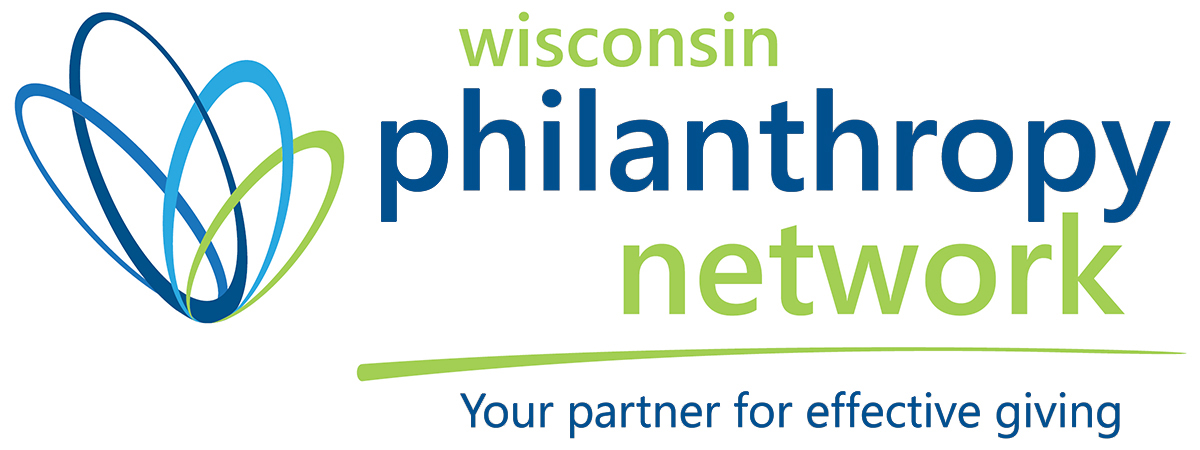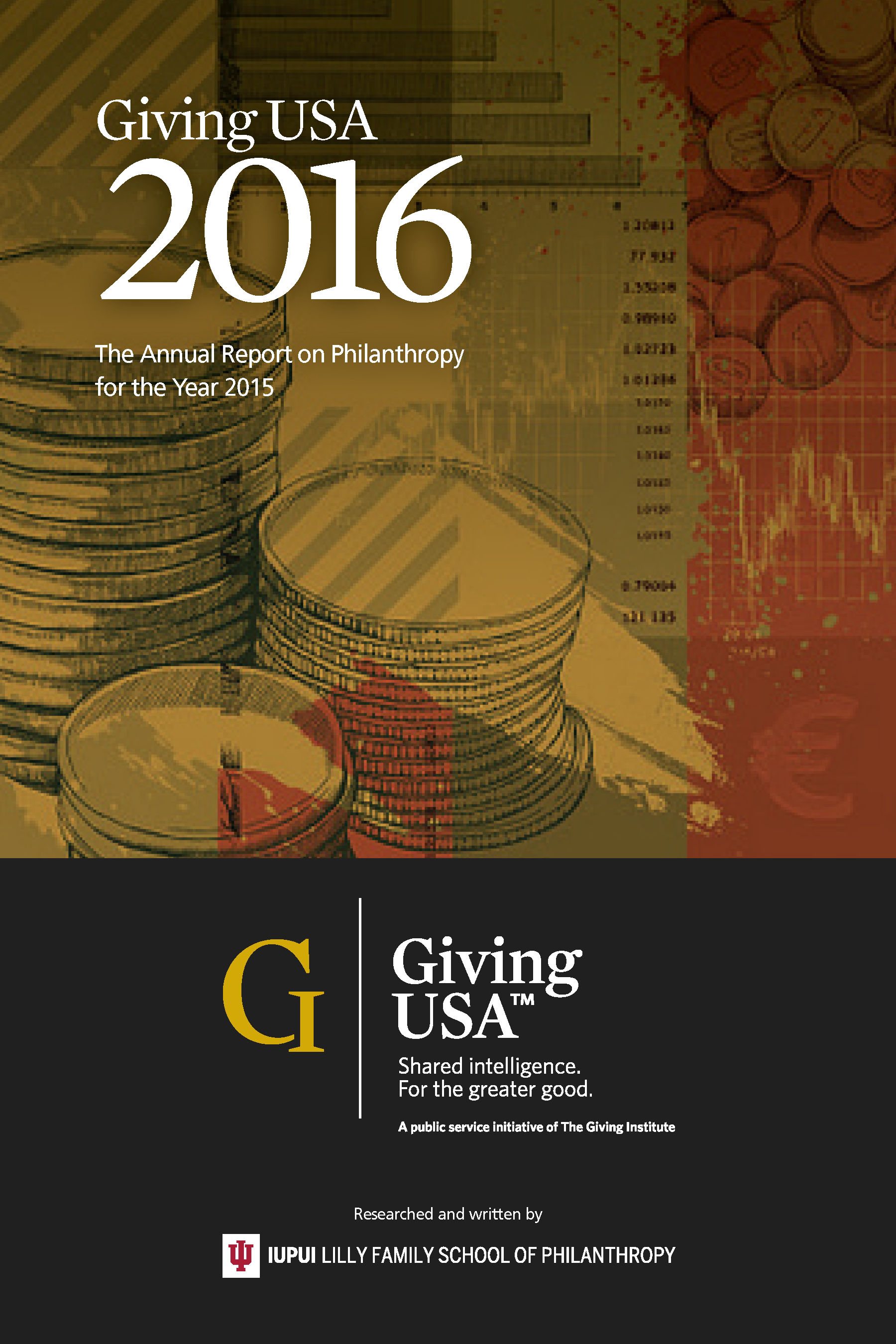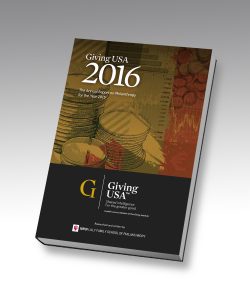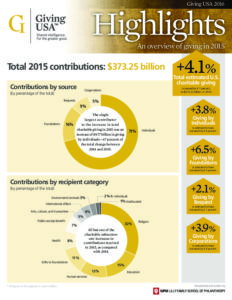According to Giving USA, "Charitable donations hit record for second year in a row, at estimated $373.25 billion.
Donations from America’s individuals, estates, foundations and corporations reached an estimated $373.25 billion in 2015, setting a record for the second year in a row, reports Giving USA 2016: The Annual Report on Philanthropy for the Year 2015, released on June 13.
That new peak in contributions is record-setting whether measured in current or inflation-adjusted dollars. In 2015, total giving grew 4.1 percent in current dollars (4.0 percent when adjusted for inflation) over 2014. The revised inflation-adjusted estimate for total giving in 2014 was $359.04 billion, with current-dollar growth of 7.8 percent, and an inflation-adjusted increase of 6.1 percent.
But that’s not the only big news about charitable giving in this year’s report.
“If you look at total giving by two-year time spans, the combined growth for 2014 and 2015 hit double digits, reaching 10.1 percent when calculated using inflation-adjusted dollars,” said Giving USA Foundation Chair W. Keith Curtis, president of nonprofit consulting firm The Curtis Group, Virginia Beach, Virginia. “But these findings embody more than numbers—they also are a symbol of the American spirit. It’s heartening that people really do want to make a difference, and they’re supporting the causes that matter to them. Americans are embracing philanthropy at a higher level than ever before.”
Charitable contributions from all four sources went up in 2015, with those from individuals once again leading the way in terms of total dollar amount, at $264.58 billion. This follows the historical pattern seen over more than six decades.
Giving USA, the longest-running and most comprehensive report of its kind in America, is published by Giving USA Foundation, a public-service initiative of The Giving Institute. It is researched and written by the Indiana University Lilly Family School of Philanthropy.
Diving even Deeper into Charitable Gifts, both Large and Small
“The last two years represent the highest and second-highest totals for giving—and the third and fourth largest percentage increases in giving—in the past 10 years, adjusted for inflation,” said Amir Pasic, Ph.D., the Eugene R. Tempel Dean of the Indiana University Lilly Family School of Philanthropy.
Pasic added that “the share of total giving going to each type of recipient was virtually the same in 2015 as it was in 2014. During and after the recession, some donors redirected donations to assist with pressing needs. The fact that the portion of the giving “pie” destined for the various subsectors has been largely consistent for the past two years suggests that giving among the broad destination categories may be stabilizing.”
Very large charitable donations—categorized here as gifts of $100 million or more—have garnered an increasing amount of attention over the past 10 to 15 years. In 2015, the very large contributions that were publicly announced totaled at least $3.3 billion.
“Each year, gifts of $100 million or more play a significant role for some individual donors and many different types of charities, and they do affect the numbers. However, Americans’ collective generosity would still be enormous even without those jaw-dropping gifts,” said Patrick M. Rooney, Ph.D., associate dean for academic affairs and research at the school. “Philanthropy is quite democratic and always has been—more people give than vote in the U.S.—and $20, $10 and $1 gifts do make a cumulative difference.”
Not only did individuals give the most; by upping their gifts 3.8 percent when measured in current dollars (and 3.7 percent when inflation-adjusted), in 2015 they were responsible for two-thirds of the year’s overall increase in total giving.
In 2015, the largest year-over-year percentage increase in contributions from sources however, came via grants made by the country’s independent, community and operating foundations, according to data provided by the Foundation Center. It went up 6.5 percent in current dollars, and 6.3 percent when adjusted for inflation. Over the past several years, foundations have seen strong asset growth, helping drive their ability to increase donations made in the form of grants
The Numbers for 2015 Charitable Giving by Source:
- Individual giving, $264.58 billion, increased 3.8 percent in current dollars (and 3.7 percent when inflation-adjusted) over 2014.
- Foundation giving, $58.46 billion, was 6.5 percent higher than 2014 (6.3 percent when inflation-adjusted).
- Charitable bequests, $31.76 billion, increased 2.1 percent (1.9 percent when inflation-adjusted) over 2014.
- Corporate giving, $18.45 billion, increased 3.9 percent (3.8 percent when inflation-adjusted) over 2014 giving.
Charitable Giving Levels Reflect Economic Conditions
Sustained growth in total giving for 2014 and 2015 could be due, in part, to at least two factors: The country’s overall economic environment continuing its path to recovery after recessionary times, and household finances seeming to stabilize.
Healthy growth among several key economic factors, including: personal consumption; personal income; disposable personal income; GDP; and, corporate pre-tax profits, influenced all four sources of giving when it came to 2015 charitable donations, and from individuals in particular.
While the S&P 500 declined steadily throughout 2015, ending essentially flat (at -0.7 percent), its double-digit growth in each of the two years prior, and attendant rise in many portfolio values, helped buoy 2015 giving.
One gauge of philanthropy’s impact on American society is the fact that charitable giving is at a level high enough for it to be part and parcel of GDP. In fact, charitable donations have hovered around 2 percent of GDP for many years. In 2015, the relevant figure was 2.1 percent, the same as in 2014 and slightly above the 40-year average of 1.9 percent.
Upon closer examination of the relationship between giving and GDP, which totaled $17.95 trillion at year’s end, Jeffrey D. Byrne, chair of The Giving Institute and president and CEO of Jeffrey D. Byrne + Associates in Kansas City, Missouri, sees something potentially even more interesting: “Between 2010 and 2015, growth in charitable donations actually outperformed growth in GDP,” he said, adding, “consider this: inflation-adjusted total giving grew at an annualized average rate of 3.6 percent during that time frame; meanwhile, GDP growth grew at an average rate of 2 percent.
“Isn’t that a fascinating statistic,” he asked, “that growth in total giving has been outpacing growth in our nation’s GDP? I believe that is information Americans can wrap their heads around and celebrate. I hope everyone who either works within philanthropy, donates to philanthropic causes, or benefits from the good work such organizations do, will participate in helping this level of growth continue and even increase.”
Giving USA's free Highlights report can be found below
The Numbers for 2015 Charitable Giving to Recipients
As noted above, all but one of nine categories that Giving USA’s research covers saw increased giving in 2015; donations to foundations was the exception.
- Religion—at $119.30 billion, 2015 giving increased 2.7 percent in current dollars, and 2.6 percent when adjusted for inflation.
- Education—giving increased to $57.48 billion, 8.9 percent more in current dollars than the 2014 total. The inflation-adjusted increase was 8.8 percent.
- Human Services—its $45.21 billion total was 4.2 percent higher, in current dollars, than in 2014. The inflation-adjusted increase was 4.1 percent.
- To Foundations—at an estimated $42.26 billion in 2015, giving declined 3.8 percent in current dollars and decreased 4.0 percent when adjusted for inflation.
- Health—the $29.81 billion estimated for 2015 giving to this category was 1.3 percent higher, in current dollars, than the 2014 estimate. When adjusted for inflation, the increase was 1.2 percent.
- Public-Society Benefit—the $26.95 billion estimate for 2015 increased 6.0 percent in current dollars over 2014. When adjusted for inflation, the increase was 5.9 percent.
- Arts/Culture/Humanities—at an estimated $17.07 billion, growth in current dollars was 7.0 percent in 2015. When adjusted for inflation, the increase was 6.8 percent.
- International Affairs—the $15.75 billion estimate for 2015 increased 17.5 percent, in current dollars, from 2014. The increase was 17.4 percent when adjusted for inflation.
- Environment/Animals—the $10.68 billion estimate for 2015 was up 6.2 percent in current dollars, and 6.1 percent when adjusted for inflation, over 2014 giving.
In addition to the above, 2 percent of 2015’s total charitable giving, $6.56 billion, went to individuals. These contributions were largely in-kind donations of medicine contributed via pharmaceutical foundations’ patient assistance programs.
Adding further context to the giving by recipient data, “Five charitable subsectors saw large increases in 2015: giving to education; arts, culture and humanities; environment/animals; public-society benefit; and international affairs. Each of these subsectors grew by more than 5 percent,” said Una Osili, Ph.D., director of research at the school. “And two of those—education and the arts—traditionally include organizations and institutions that wealthy donors are most likely to support. In addition, the increase in education giving was fueled by a number of very large gifts to colleges and universities.”






